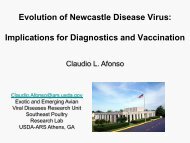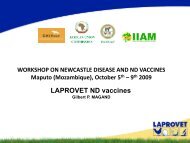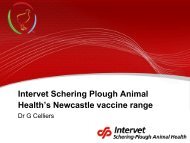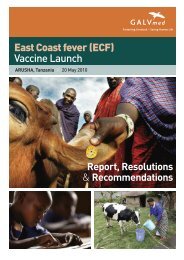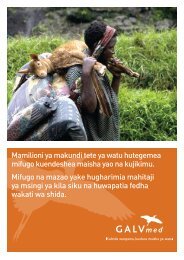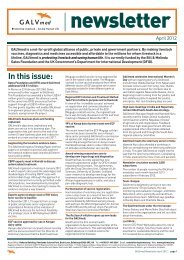A Path to Prosperity New Directions for African Livestock
GALVmed Impetus Strategy Paper
GALVmed Impetus Strategy Paper
- No tags were found...
You also want an ePaper? Increase the reach of your titles
YUMPU automatically turns print PDFs into web optimized ePapers that Google loves.
Global Bodies<br />
The main global bodies working <strong>for</strong> lives<strong>to</strong>ck<br />
development in Africa have complementary<br />
and relatively well defined mandates.<br />
The World Organisation<br />
<strong>for</strong> Animal Health (OIE)<br />
The OIE is an au<strong>to</strong>nomous intergovernmental body<br />
that pre-dates the UN. Its mission is <strong>to</strong> guarantee<br />
the transparency of animal disease status<br />
world-wide, manage veterinary scientific<br />
in<strong>for</strong>mation and provide expertise in and promote<br />
international solidarity <strong>for</strong> the control of animal<br />
disease. The OIE, as the WTO recognized official<br />
and sole intergovernmental global animal health<br />
and zoonosis standard-setting body, supports<br />
and maintains international expertise on the<br />
international standards, available <strong>to</strong> all OIE<br />
Members. As such, a major role of the OIE is <strong>to</strong><br />
produce scientifically-based standards and<br />
guidelines. Since the recognition of animal health<br />
standards, by the WTO, as the scientific reference<br />
points <strong>for</strong> the safety of international trade of animals<br />
and animal products, the development of OIE<br />
standards <strong>for</strong> international trade has assumed a<br />
prominent role.<br />
The work of the OIE on standards can be divided in<strong>to</strong><br />
two broad categories:<br />
> Standards contained in the Terrestrial Animal<br />
Health Code and Aquatic Animal Health Code,<br />
dealing with prevention and control of animal<br />
diseases including zoonoses, animal welfare,<br />
sanitary safety (including animal production food<br />
safety), and sanitary safety of trade in animals<br />
and animal products; and<br />
> Biological standards contained in the Manual of<br />
Diagnostic Tests and Vaccines <strong>for</strong> Terrestrial<br />
Animals and Manual of Diagnostic Tests <strong>for</strong><br />
Aquatic Animals, which provide, as a companion<br />
document <strong>to</strong> the Codes, a harmonised approach<br />
<strong>to</strong> disease diagnosis by describing internationally<br />
agreed labora<strong>to</strong>ry diagnostic techniques. The<br />
Terrestrial Manual also includes requirements<br />
<strong>for</strong> the production and control of biological<br />
products (mainly vaccines).<br />
Furthermore, the OIE guidelines and recommendations<br />
are given in specific publications separate from the<br />
Codes and Manuals.<br />
The OIE also increasingly focuses on assisting<br />
developing countries in areas of animal health<br />
capacity building, as related <strong>to</strong> the enhancement of<br />
efficient veterinary services under good governance,<br />
a global public good, <strong>to</strong> regulation and legislation,<br />
labora<strong>to</strong>ries and the strengthening and evaluation of<br />
public veterinary services. The OIE has developed a<br />
<strong>to</strong>ol <strong>for</strong> the review of per<strong>for</strong>mance of veterinary<br />
services (the PVS Tool), using OIE international<br />
standards on quality and evaluation.<br />
The OIE PVS Tool promotes a culture of raising<br />
awareness and continual improvement, which can<br />
be used depending on the level of interest, priorities<br />
and commitment of the veterinary services and their<br />
stakeholders. The PVS <strong>Path</strong>way involves the<br />
systematic evaluation of veterinary services <strong>to</strong><br />
international standards (PVS Evaluation), a costed<br />
plan based on integrating the evaluation with<br />
national priorities (PVS Gap Analysis), access <strong>to</strong> OIE<br />
resources, strategies and services (veterinary<br />
legislation, public/private investments, veterinary<br />
education and labora<strong>to</strong>ries), and a consistent<br />
mechanism <strong>for</strong> the moni<strong>to</strong>ring and evaluation<br />
of progress (PVS <strong>Path</strong>way follow-up mission).<br />
It can support round tables with donors and<br />
partners and support the preparation of<br />
investment programmes/pre-appraisal of projects<br />
and possible modernisation of veterinary legislation.<br />
OIE has almost 180 member countries and their<br />
delegates, mostly Chief Veterinary Officers, have<br />
supported the secretariat <strong>to</strong> keep abreast of<br />
developing animal health issues. The organisation is,<br />
in addition <strong>to</strong> its work on trade standards, examining<br />
issues of importance <strong>to</strong> developing countries.<br />
These include the impact of climate change on<br />
animal diseases and production and developing<br />
guidance on animal identification and traceability,<br />
animal welfare and private standards related <strong>to</strong><br />
animal health.<br />
OIE has built strong links with lives<strong>to</strong>ck industry and<br />
other relevant bodies, It has over 40 cooperative<br />
agreements with international governmental and<br />
non-governmental organisations (NGOs), such as<br />
the safe supply of af<strong>for</strong>dable food everywhere<br />
(SSAFE) Initiative and in<strong>for</strong>mal agreements <strong>for</strong><br />
cooperation with other organisations.<br />
The Impetus Strategy Paper I Page 56



